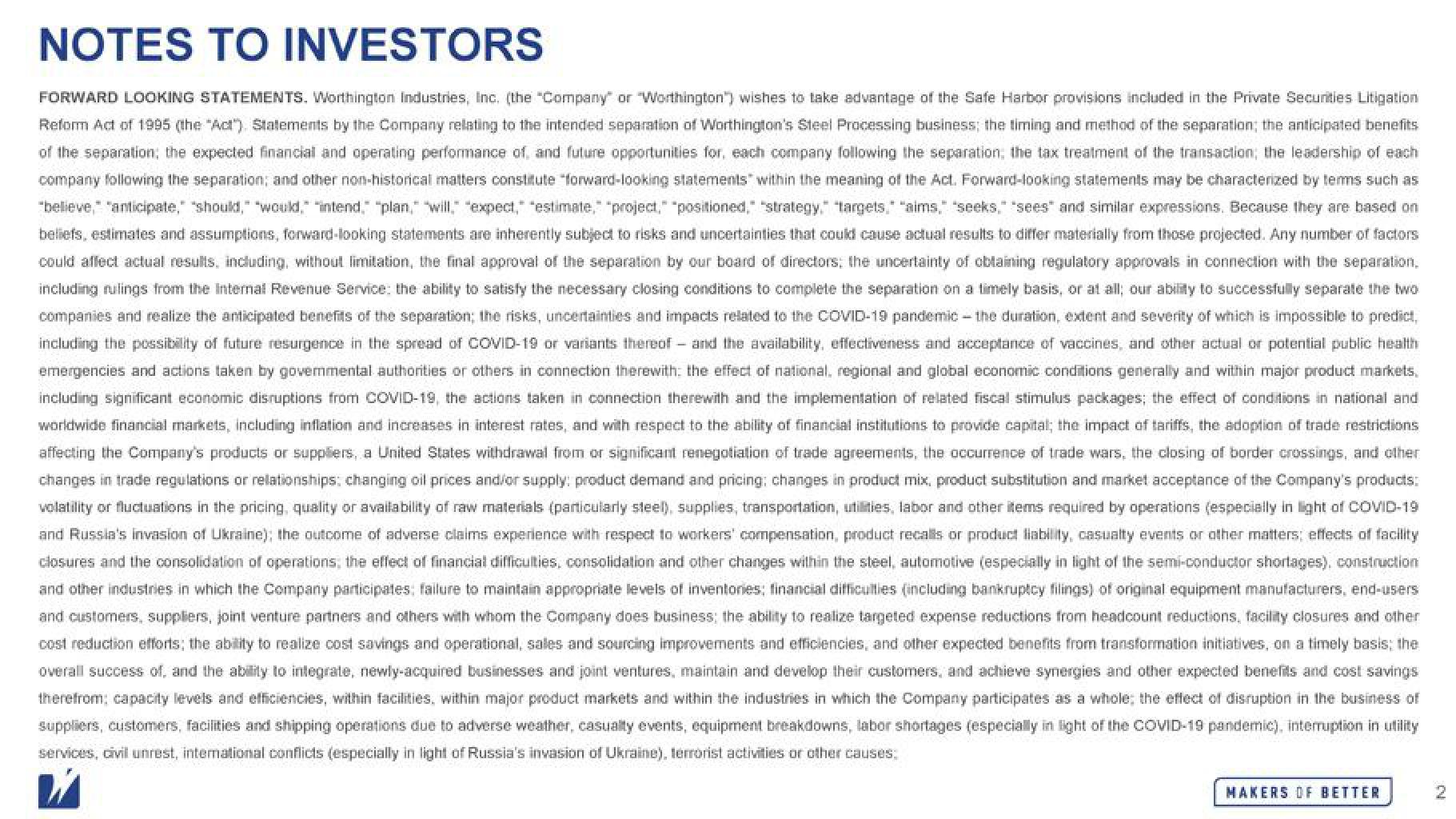Worthington Industries Mergers and Acquisitions Presentation Deck
NOTES TO INVESTORS
FORWARD LOOKING STATEMENTS. Worthington Industries, Inc. (the "Company" or "Worthington") wishes to take advantage of the Safe Harbor provisions included in the Private Secunties Litigation
Reform Act of 1995 (the "Act). Statements by the Company relating to the intended separation of Worthington's Steel Processing business; the timing and method of the separation; the anticipated benefits
of the separation, the expected financial and operating performance of, and future opportunities for, each company following the separation, the tax treatment of the transaction; the leadership of each
company following the separation; and other non-historical matters constitute "forward-looking statements within the meaning of the Act. Forward-looking statements may be characterized by terms such as
"believe," "anticipate," "should," "would," "intend," "plan," "will," "expect," "estimate," "project," "positioned," "strategy," targets," "aims," "seeks," "sees" and similar expressions. Because they are based on
beliefs, estimates and assumptions, forward-looking statements are inherently subject to risks and uncertainties that could cause actual results to differ materially from those projected. Any number of factors
could affect actual results, including, without limitation, the final approval of the separation by our board of directors; the uncertainty of obtaining regulatory approvals in connection with the separation,
including rulings from the Internal Revenue Service: the ability to satisfy the necessary closing conditions to complete the separation on a timely basis, or at all; our ability to successfully separate the two
companies and realize the anticipated benefits of the separation; the risks, uncertainties and impacts related to the COVID-19 pandemic the duration, extent and severity of which is impossible to predict,
including the possibility of future resurgence in the spread of COVID-19 or variants thereof and the availability, effectiveness and acceptance of vaccines, and other actual or potential public health
emergencies and actions taken by governmental authorities or others in connection therewith: the effect of national, regional and global economic conditions generally and within major product markets.
including significant economic disruptions from COVID-19, the actions taken in connection therewith and the implementation of related fiscal stimulus packages; the effect of conditions in national and
worldwide financial markets, including inflation and increases in interest rates, and with respect to the ability of financial institutions to provide capital; the impact of tariffs, the adoption of trade restrictions
affecting the Company's products or suppliers, a United States withdrawal from or significant renegotiation of trade agreements, the occurrence of trade wars, the closing of border crossings, and other
changes in trade regulations or relationships: changing oil prices and/or supply: product demand and pricing; changes in product mix, product substitution and market acceptance of the Company's products:
volatility or fluctuations in the pricing, quality or availability of raw materials (particularly steel), supplies, transportation, utilities, labor and other items required by operations (especially in light of COVID-19
and Russia's invasion of Ukraine); the outcome of adverse claims experience with respect to workers' compensation, product recalls or product liability, casualty events or other matters: effects of facility
closures and the consolidation of operations, the effect of financial difficulties, consolidation and other changes within the steel, automotive (especially in light of the semi-conductor shortages), construction
and other industries in which the Company participates; failure to maintain appropriate levels of inventories; financial difficulties (including bankruptcy filings) of original equipment manufacturers, end-users
and customers, suppliers, joint venture partners and others with whom the Company does business; the ability to realize targeted expense reductions from headcount reductions, facility closures and other
cost reduction efforts; the ability to realize cost savings and operational, sales and sourcing improvements and efficiencies, and other expected benefits from transformation initiatives, on a timely basis; the
overall success of, and the ability to integrate, newly-acquired businesses and joint ventures, maintain and develop their customers, and achieve synergies and other expected benefits and cost savings
therefrom:
levels and efficiencies, within facilities, within major product markets and within the industries in which the Company participates as a whole, the effect of disruption in the business of
suppliers, customers, facilities and shipping operations due to adverse weather, casualty events, equipment breakdowns, labor shortages (especially in light of the COVID-19 pandemic), interruption in utility
services, civil unrest, international conflicts (especially in light of Russia's invasion of Ukraine), terrorist activities or other causes;
MAKERS OF BETTER
2View entire presentation